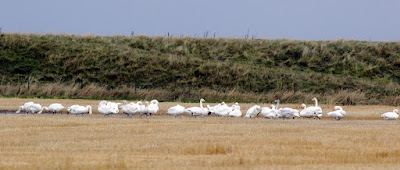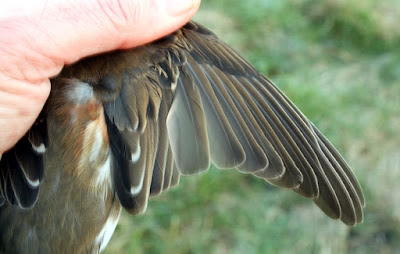The fog didn’t clear until about 1pm. That would leave about three hours birding before the light failed and the return of the evening mist; not ideal. Meanwhile the garden held a few birds by way of mainly Goldfinches, a species which has been unusually scarce here all autumn.
When I saw a Nuthatch on the feeders and a Mistle Thrush in the apple tree I decided to do a spot of garden ringing.
I didn’t catch the thrush or the Nuthatch but 17 new birds was pretty good for a few hours work - 7 Goldfinch, 5 Coal Tit, 2 Goldcrest, 2 Great Tit and 1 Blue Tit.
Goldcrest
Great Tit
Goldfinch
This autumn has seen good numbers of both Goldcrests and Coal Tits, two species chiefly associated with conifer forest. Although not strictly migratory the Coal Tit is known to experience irregular irruptions caused by food shortages in their preferred woodland habitats. It is during such times that Coal Tits move into gardens and other habitats and when bird ringers catch more Coal Tits than they normally would. The majority of birds are found to be first years and out of an catch of say 15 or 20 Coal Tits it is normal that 99% are birds of the year and that an adult is the exception to the rule.
“Coal” in the bird’s English name may simply refer to the mainly black and grey colour compared to the more colourful and common British tits, the Great Tit and the Blue Tit. A German name for the Coal Tit is "Tannenmeise" which translates as "fir tit", perhaps a more suitable descriptive name for a species able to exploit an otherwise birdless coniferous forest?
Coal Tit
The Coal Tit has a huge distribution range occurring from the Atlantic to the Pacific and from boreal forests north of the Arctic Circle to the montane forests of the Himalayas, China and Taiwan. It’s a species to benefit from extensive planting of conifers in Ireland and Scotland by extending its UK range into the Western Isles of Scotland and the Atlantic coast of Ireland and so increase its overall population.
Range and Distribution of Coal Tit
From Wiki and for my North American readers who will note that the Coal Tit is almost identical to one or more of their chickadees - "Most authorities still treat the Coal Tit Periparus ater in the subgenus Periparus, but the American Ornithologists' Union considers Periparus a distinct genus. This is supported by mtDNA cytochrome b sequence analysis; Periparus seems to be closer to the Poecile tits and chickadees than to the Great Tit and its relatives."
The fog returned for overnight and tomorrow morning but be sure that there are more birds, photos and news soon.
Linking today to Stewart's World Bird Wednesday.
Linking today to Stewart's World Bird Wednesday.




















































.jpg)












